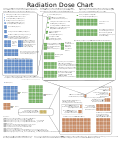Ionizing radiation: Difference between revisions
No edit summary |
CSV import |
||
| Line 48: | Line 48: | ||
[[Category:Radiation health effects]] | [[Category:Radiation health effects]] | ||
[[Category:Nuclear technology]] | [[Category:Nuclear technology]] | ||
<gallery> | |||
File:Radiation_warning_symbol.svg|Ionizing radiation | |||
File:Alfa_beta_gamma_neutron_radiation.svg|Ionizing radiation | |||
File:Cloud_chambers_played_an_important_role_of_particle_detectors.jpg|Ionizing radiation | |||
File:EM-spectrum.svg|Ionizing radiation | |||
File:Pb-gamma-xs.svg|Ionizing radiation | |||
File:Strahlenarten_en.svg|Ionizing radiation | |||
File:Cyclotron_with_glowing_beam.jpg|Ionizing radiation | |||
File:Radioactivity_and_radiation.png|Ionizing radiation | |||
File:G_radiation-level_scale_01.png|Ionizing radiation | |||
File:Exposure_chart-XKCD.svg|Ionizing radiation | |||
File:Radiological_exposure_from_daily_life.png|Ionizing radiation | |||
File:Radioactive.svg|Ionizing radiation | |||
</gallery> | |||
Latest revision as of 12:04, 18 February 2025
Ionizing radiation is a type of radiation that carries enough energy to detach electrons from atoms or molecules, thus ionizing them. Sources include X-ray procedures, radioactive substances, cosmic rays that penetrate the Earth's atmosphere, and nuclear reactions. Ionizing radiation is so named because it has enough energy to ionize atoms or molecules by overcoming the binding energy of electrons. This ionization process can lead to changes in the properties of atoms and molecules, and can cause damage to living cells.
Types of Ionizing Radiation[edit]
There are several types of ionizing radiation, each with differing properties:
- Alpha particles are heavy, positively charged particles that can cause significant damage but cannot penetrate the skin.
- Beta particles are lighter and can penetrate further, potentially causing skin burns and injury to other tissues.
- Gamma rays and X-rays are electromagnetic radiation that can penetrate the body and cause damage to internal tissues and organs.
- Neutrons are uncharged particles that can penetrate deeply into tissues and are particularly damaging.
Sources of Ionizing Radiation[edit]
Ionizing radiation can be produced from a variety of sources:
- X-ray procedures, used in medicine and industry, produce ionizing radiation.
- Radioactive substances, either natural or man-made, emit ionizing radiation as they decay.
- Cosmic rays, originating from outer space, contribute to the background ionizing radiation on Earth.
- Nuclear reactions, such as those occurring in nuclear power plants or atomic bombs, produce large amounts of ionizing radiation.
Health Effects[edit]
At high doses, ionizing radiation increases chemical activity inside cells, which can lead to health risks. This can cause damage to the DNA in cells, which in turn can lead to cancer. High doses can also lead to radiation sickness, a serious illness that can be fatal.
Protection[edit]
Protection from ionizing radiation involves minimizing exposure time, maximizing distance from the source, and using shielding materials.
See Also[edit]
|
|
|
| Radiation (physics and health) | ||||||||
|---|---|---|---|---|---|---|---|---|
|
| Cancer-causing materials and agents (carcinogens) | ||||
|---|---|---|---|---|
|
| Radiation poisoning | ||||||
|---|---|---|---|---|---|---|
|
| Radiation protection | ||||||||
|---|---|---|---|---|---|---|---|---|
|
-
Ionizing radiation
-
Ionizing radiation
-
Ionizing radiation
-
Ionizing radiation
-
Ionizing radiation
-
Ionizing radiation
-
Ionizing radiation
-
Ionizing radiation
-
Ionizing radiation
-
Ionizing radiation
-
Ionizing radiation
-
Ionizing radiation














